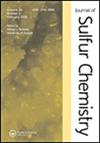Desulfurization of light and heavy gas oil from crudes of Kurdistan region-Iraq by oxidation and solvent extraction
IF 1.6
3区 化学
Q3 CHEMISTRY, MULTIDISCIPLINARY
引用次数: 0
Abstract
This study analyzes four distinct crude oil varieties from the Kurdistan Region-Iraq: Taq-Taq (TQ), Sarqala (SA), Khurmala (Kh), and Tawke (TA). Fractionation produced five categories: naphtha, kerosene, light gas oil (LGO), heavy gas oil (HGO), and fuel oil. The research focused on distillation cuts of LGO (241–300°C) and HGO (301–360°C), which contained organic sulfur compounds, contributing to environmental pollution and health hazards during combustion. Oxidative desulfurization (ODS) using hydrogen peroxide and acetic acid at 75°C for 12 hours significantly reduced sulfur content. LGO sulfur content decreased from 0.72% to 0.11% wt in SA and from 2.02% to 0.50% wt in TA, achieving desulfurization efficiencies of 84.72% and 74.25%, respectively. In HGO, sulfur content dropped from 3.67% to 1.78% wt in Kh, with 51.49% efficiency. Gas oil recovery after oxidation ranged from 92.71% to 96.28%. Solvent extraction with acetonitrile, methanol, and acetic acid further enhanced desulfurization, with pre-oxidation extraction achieving 19.42% efficiency in LGO, increasing to 86% post-oxidation. Gas chromatography with a flame photometric detector (PFPD) assessed sulfur removal, highlighting the combined effects of oxidation and extraction on sulfur compound reduction. This approach demonstrated the efficiency of ODS in mitigating sulfur-related impacts.
伊拉克库尔德斯坦地区原油轻、重质气氧化萃取脱硫研究
本研究分析了来自伊拉克库尔德斯坦地区的四种不同的原油品种:Taq-Taq (TQ)、Sarqala (SA)、Khurmala (Kh)和Tawke (TA)。分馏生产了五种油:石脑油、煤油、轻质油、重质油和燃料油。研究重点是LGO(241-300°C)和HGO(301-360°C)的蒸馏切割,它们含有有机硫化合物,在燃烧过程中会造成环境污染和健康危害。过氧化氢和醋酸在75℃下氧化脱硫12小时,可显著降低硫含量。在SA中,LGO的硫含量从0.72%降至0.11%,在TA中,LGO的硫含量从2.02%降至0.50%,脱硫效率分别为84.72%和74.25%。在HGO中,硫含量从3.67%降至1.78% (wt / Kh),效率为51.49%。氧化后天然气采收率为92.71% ~ 96.28%。乙腈、甲醇和乙酸溶剂萃取进一步提高了脱硫效果,氧化前萃取对LGO的萃取效率为19.42%,氧化后萃取效率提高到86%。气相色谱法与火焰光度检测器(PFPD)评估了硫的去除,突出了氧化和萃取对硫化合物还原的综合影响。该方法证明了ODS在减轻硫相关影响方面的效率。
本文章由计算机程序翻译,如有差异,请以英文原文为准。
求助全文
约1分钟内获得全文
求助全文
来源期刊

Journal of Sulfur Chemistry
CHEMISTRY, MULTIDISCIPLINARY-
CiteScore
4.10
自引率
9.10%
发文量
38
审稿时长
6-12 weeks
期刊介绍:
The Journal of Sulfur Chemistry is an international journal for the dissemination of scientific results in the rapidly expanding realm of sulfur chemistry. The journal publishes high quality reviews, full papers and communications in the following areas: organic and inorganic chemistry, industrial chemistry, materials and polymer chemistry, biological chemistry and interdisciplinary studies directly related to sulfur science.
Papers outlining theoretical, physical, mechanistic or synthetic studies pertaining to sulfur chemistry are welcome. Hence the target audience is made up of academic and industrial chemists with peripheral or focused interests in sulfur chemistry. Manuscripts that truly define the aims of the journal include, but are not limited to, those that offer: a) innovative use of sulfur reagents; b) new synthetic approaches to sulfur-containing biomolecules, materials or organic and organometallic compounds; c) theoretical and physical studies that facilitate the understanding of sulfur structure, bonding or reactivity; d) catalytic, selective, synthetically useful or noteworthy transformations of sulfur containing molecules; e) industrial applications of sulfur chemistry; f) unique sulfur atom or molecule involvement in interfacial phenomena; g) descriptions of solid phase or combinatorial methods involving sulfur containing substrates. Submissions pertaining to related atoms such as selenium and tellurium are also welcome. Articles offering routine heterocycle formation through established reactions of sulfur containing substrates are outside the scope of the journal.
 求助内容:
求助内容: 应助结果提醒方式:
应助结果提醒方式:


